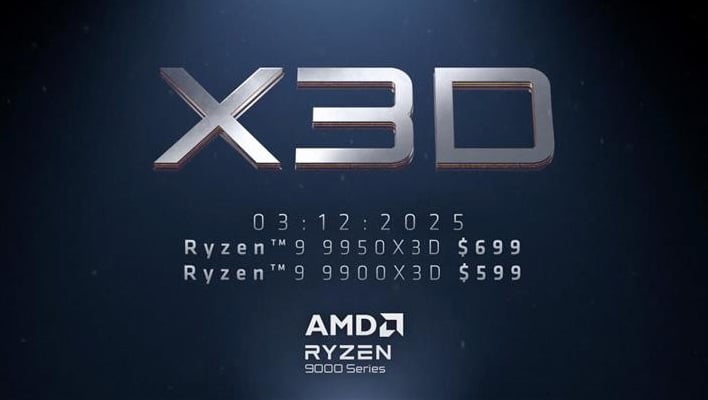AMD has announced when its next two Zen 5 desktop chips with 3D V-Cache—the Ryzen 9 9950X3D and Ryzen 9 9900X3D—will release to retail and how much they will cost. In
keeping with its promise to release both chips in the first quarter of 2025 (which it announced at the Consumer Electronics Show in Las Vegas earlier this year), both processors will be available on
March 12 (next Wednesday).
As for pricing, the flagship Ryzen 9 9950X3D carries a $699 MSRP while the Ryzen 9 9900X3D is officially priced at $599.
They follow the retail launch of AMD's
Ryzen 7 9800X3D, which debuted at
$479 and remains at the price, if you can find it in stock—it's currently listed for
$549.99 at Amazon, but that's by way of a marketplace seller, and it's
sold out at Best Buy and even AMD's own webstore.
That's not super surprising, given the combination of AMD's more-than-capable Zen 5 architecture and gaming-friendly 3D V-Cache. In our
Ryzen 7 9800X3D review, we called it an ideal CPU for PC gamers, and buyers seem to be in agreement—it ranks high on Amazon's list of
best selling CPUs (number three, at the time of this writing).
We've already covered the unveiling of both new additions, but to quickly recap, the Ryzen 9 9950X3D and 9900X3D offer higher core and thread counts, and bigger piles of cache. For the Ryzen 9 9950X3D, that translates into 16 cores and 32 threads clocked at 4.3GHz (base) to 5.7GHz (max boost), along with 128MB of L3 cache and 144MB of total cache (L3 + L2).
Meanwhile, the Ryzen 9 9900X3D is a 12-core/24-thread chip with a 4.4GHz base clock, up to a 5.5GHz boost clock, the same 128MB of L3 cache, and 140MB of total cache.
For comparison, the Ryzen 7 9800X3D is an 8-core/16-thread processor with a 4.7GHz base clock, up to a 5.2GHz boost clock, 96MB of L3 cache, and 104MB of total cache.
It's also worth reiterating that all of these chips employ AMD's second-generation 3D V-Cache. Unlike previous generation designs, for the Ryzen 9000X3D series, AMD relocated the 3D V-Cache to below the processor. The reason this matters is because shifts the core complex die (CCD) closer to the cooler, which in turn enabled AMD to crank the clocks and support overclocking.
How the newest parts fare is something we'll dive into in our upcoming review coverage of both chips. So, stay tuned.



